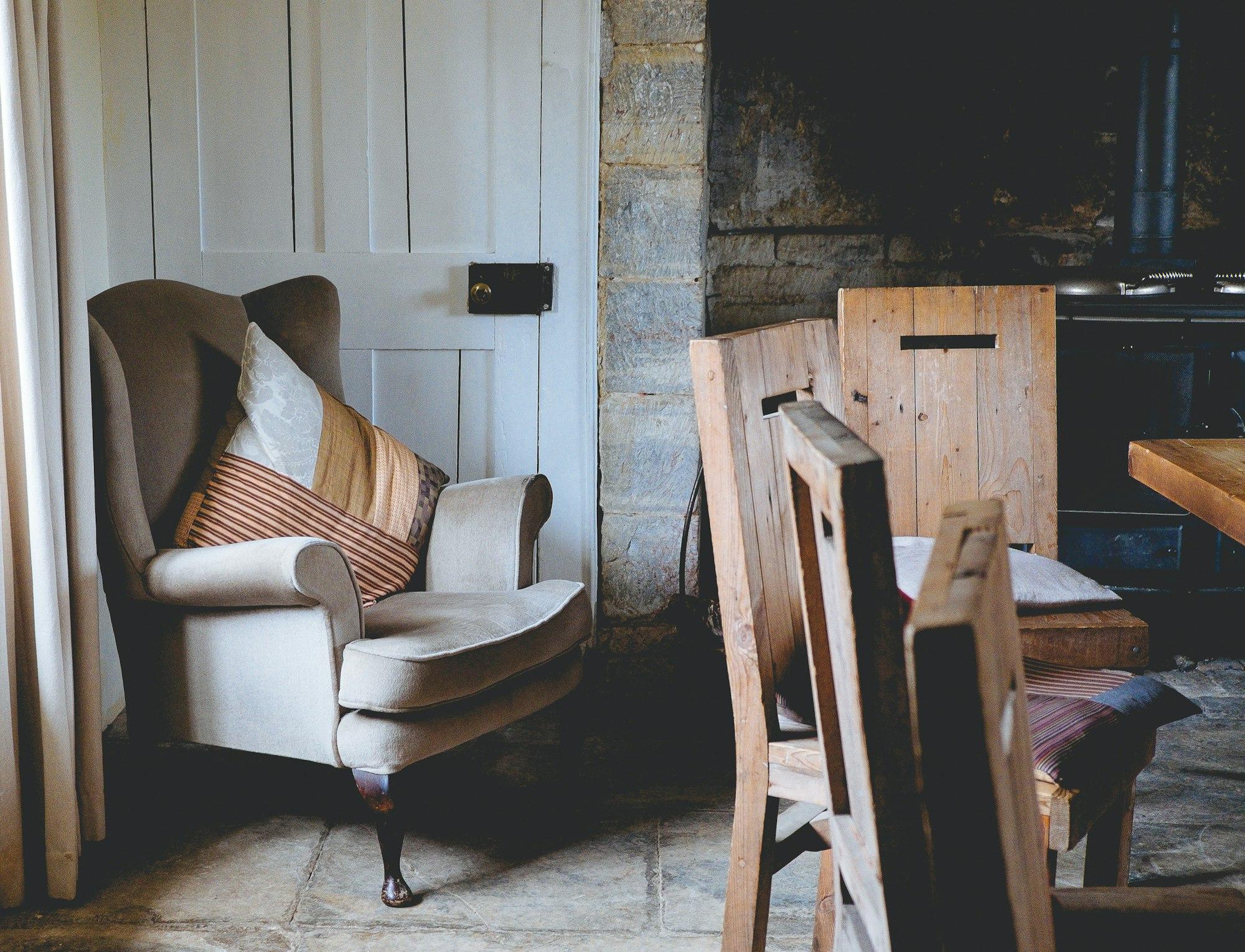What is a Wingback Chair?
With high backs and embracing wings, these regal seats offer more than just comfort—they bring a touch of timeless sophistication to any room, proving that true style never goes out of fashion.

Photo by Annie Spratt
In the realm of seating, few chairs command attention quite like the wingback. With its tall back, curved headrest, and distinctive side wings, it's the chair equivalent of a power suit – authoritative, elegant, and impossible to ignore. But this chair isn't just about making a statement; it's a piece of furniture with a rich history and a surprisingly practical origin.
The Essence of a Wingback Chair
A wingback chair, also known as a wing chair or fireside chair, is characterized by its high back, winged sides, and generous proportions. These wings, which stretch from the back of the chair to the arm supports, were originally designed to protect sitters from drafts and trap the heat from a fireplace. Today, they serve more as a distinctive design element, giving the chair its unmistakable silhouette.
A Journey Through Time: The Evolution of the Wingback
The wingback chair first spread its wings (pun intended) in late 17th century England. Born out of a need for warmth in drafty homes, it quickly became a staple in parlors and drawing rooms across Europe and America.
As central heating made its drafty-room-fighting abilities less necessary, the wingback adapted. It transformed from a purely functional piece into a symbol of sophistication. In the 20th century, designers began experimenting with its form, creating modernist interpretations that maintained the iconic silhouette while playing with proportions and materials.
Today, the wingback chair stands as a versatile piece that can anchor a traditional living room or add a touch of the classic to a contemporary space.
Anatomy of a Wingback Chair
Understanding the components of a wingback chair helps appreciate its design:
- High Back: Extends above the head of the sitter, often with a curved top.
- Wings: The distinctive side panels that extend from the back.
- Arms: Usually padded and may be straight or scrolled.
- Seat: Typically deep and comfortable, often with a loose cushion.
- Legs: Can vary in style from ornate carved wood to sleek metal.
Types of Wingback Chairs
While the basic silhouette remains constant, wingback chairs come in various styles:
- Traditional: Features rolled arms, turned legs, and often showcases patterned upholstery.
- Modern: Sleeker lines, minimalist fabric, and sometimes unexpected materials like molded plastic.
- Transitional: Blends traditional shape with contemporary fabrics or finishes.
- Tufted: Incorporates button tufting for added texture and visual interest.
- Reclining: Modern adaptations that incorporate reclining mechanisms for added comfort.

The Versatility of Wingback Chairs
One of the wingback's greatest strengths is its adaptability to various settings:
- Living Room: As a statement accent chair or paired for a symmetrical look.
- Bedroom: In a corner as a reading nook or at a vanity.
- Home Office: As a stately desk chair.
- Dining Room: Used as head chairs at a dining table for a regal touch.
- Entryway: To create a welcoming seating area.
Choosing the Right Wingback Chair
When selecting a wingback chair, consider these factors:
- Size: Wingbacks are generally large chairs. Measure your space carefully to ensure a good fit.
- Style: Choose a design that complements your existing decor.
- Upholstery: From leather to linen, the fabric choice can dramatically change the chair's look and feel.
- Comfort: Sit in the chair if possible. Consider the firmness of the cushion and the angle of the back.
- Purpose: Will it be a showpiece or an everyday reading chair? This can inform your choice of style and fabric.
Styling Your Wingback Chair
The wingback chair is a versatile piece that can adapt to various decor styles:
- In a traditional setting, pair with a classic side table and reading lamp.
- For a modern twist, choose a wingback in a bold color or unexpected fabric like velvet.
- Create a cozy reading nook by adding an ottoman and a throw blanket.
- In a minimalist space, let a sleek wingback in a neutral tone be a subtle focal point.
- Use two wingbacks facing each other with a small table between for an intimate conversation area.
Wingback Chairs vs. Other Accent Chairs
While wingbacks have unique advantages, it's worth comparing them to other accent chair styles:
- Club Chairs: Lower backed and usually wider, offering a more relaxed seating position.
- Bergère Chairs: Similar in grandeur but with closed arms and looser cushions.
- Slipper Chairs: Armless and lower to the ground, offering a more minimalist profile.
- Chaise Lounges: Offer full-body support for reclining, unlike the upright position of wingbacks.
Caring for Your Wingback Chair
To keep your wingback chair looking its best:
- Vacuum regularly using upholstery attachments.
- Treat spills immediately to prevent staining.
- For leather wingbacks, condition the leather every 6-12 months.
- Rotate the chair periodically if it's in direct sunlight to prevent uneven fading.
- Consider professional cleaning annually, especially for light-colored fabrics.
Final Thoughts
The wingback chair is more than just a seating option – it's a piece of history, a design icon, and a versatile player in the world of interior decor. Its journey from a practical solution for drafty rooms to a symbol of elegance and comfort is a testament to great design's ability to evolve while maintaining its core identity.
Whether you're looking to add a touch of traditional elegance to your space, create a cozy reading nook, or simply make a statement with your furniture, a wingback chair offers a solution that's as stylish as it is comfortable. It's a reminder that sometimes, the classics never go out of style – they just get better with age.
So, if you're in the market for a chair that combines history, style, and comfort, consider the wingback. It's been embracing people (quite literally) for centuries, and it's ready to wrap its wings around you too.
Check out wingback chairs and other accent chair styles on Spoken and never overpay making your home beautiful!
Quick facts
What is the purpose of a wingback chair?
The primary purpose of a wingback chair is to provide comfort and protect against drafts. The high back and side "wings" were originally designed to shield the sitter from cold air and fireplace heat. Today, wingback chairs serve as statement pieces in interior design, offering both style and cozy seating options for reading or relaxing.
Is a wingback chair good for your back?
Wingback chairs can be good for your back due to their tall, supportive backrest which promotes good posture. The high back provides lumbar support and helps maintain proper spine alignment. However, individual comfort may vary based on the chair's specific design and padding. For optimal back health, it's important to choose a chair that fits your body well.
Are Wing-Back chairs dated?
While wingback chairs have a classic, traditional origin, they are not considered dated. These chairs have evolved with contemporary designs and continue to be popular in modern interiors. Their versatile style allows them to fit various decor themes, from traditional to transitional and even modern spaces. Designers often update wingback chairs with fresh fabrics and finishes to keep them current.
Are wingback chairs still in style?
Yes, wingback chairs are still very much in style. They've maintained their popularity due to their versatility and ability to adapt to different design aesthetics. Modern interpretations of wingback chairs often feature updated fabrics, colors, and proportions, making them suitable for contemporary interiors. Their classic silhouette continues to be appreciated in both traditional and modern design schemes.

Pavan Jadhaw
Software Engineer at Spoken
Pavan is a Fullstack Engineer at Spoken. He's passionate about both software and mechanical engineering. When he's not coding, you’ll find him tinkering with his homeserver, working on his motorcycle, or building custom mechanical keyboards. He’s a fan of minimalistic and functional decor.
Read more